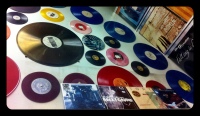
Though streaming offers new opportunities to both musicians and listeners, vinyl proves to be more lucrative. (Courtesy of Flickr)
By Mark McNulty
Billboard reported that in 2015, vinyl sales in the United States generated more revenue than the advertising on Youtube, Soundcloud and Spotify combined. According to the Recording Industry Association of America, vinyl record sales totaled $416 million while ad revenues from the major streaming services earned $385 million.
There are two parallel storylines at play here: American’s growing fondness for the hands-on listening experience of vinyl which ultimately puts more money in the pockets of artists while, in comparison, a new streaming model collects paltry sums for artists. The number of people who actually purchase music has decreased steadily since the digital revolution in the early 2000s, leaving merchandizing and ticket sales as an artist’s primary source of revenue.
“Vinyl records can fall into the category of merchandise when an artist personally presses and sells the vinyls” said Noah Padawer Curry, head of Onamazu, a hip-hop label based in New York City. “An artist typically pockets 100 percent of this revenue, and fans experience the music in a more intimate fashion.”
If style is cyclical and sound is style, it is not surprising that vinyls are making a comeback. Record Store Day began in 2008 as a way to celebrate the history of vinyl and the record store itself.
When a person is used to digital streaming, walking into a record store is like going to a professional baseball game for the first time instead of listening to games on the radio. In 2009, approximately 85 records were released or re-released on Record Store Day. This year, over 500 records are being pressed for release on Record Store Day on April 16.
Streaming services like Youtube, Spotify and Soundcloud have been notoriously poor at compensating artists for streams of their music. Artists like Prince, Tool, Taylor Swift and Radiohead’s Thom Yorke even boycott some of the services. Swift, whose album 1989 was the second highest-selling vinyl in 2015, refuses to host her music on Spotify. “I’m not willing to contribute my life’s work to an experiment that I don’t feel fairly compensates the writers, producers, artists and creators of this music,” she told Rolling Stone.
So how does Spotify pay artists, and how much of the $385 million in ad revenue makes it into the pockets of deserving artists? It depends on a number of factors. According to SpotifyArtists.com, the average per-stream payout to artists is between .006 to .0084 cents. This is averaged across Spotify’s tiers of service, from the subscription model to the free, ad-supported service.
Spotify also offers lucrative exclusive access deals to artists like Red Hot Chili Peppers and Metallica, but all an emerging artist can really gain from Spotify is exposure. Thom Yorke, whose solo albums are not available on any streaming service, has criticized Spotify for this, but exposure is not bereft of value.
With merchandise and ticket sales bringing in the lion’s share of an artist’s livelihood, solid exposure through streaming services can help bring people to concerts and in turn, to the mercy table where a stack of vinyls may be sitting.
Licensing agreements often determine the amount of ad revenue that rights holders (musicians and labels) will see. Soundcloud, which recently announced its pay-for-premium-play subscription service called Soundcloud Go, has agreements with the three major music labels, Universal Music Group, Sony BMG and Warner Music Group, which allows the service to legally host the music owned by these labels.
In those agreements, Soundcloud and the labels agree that a certain percentage of ad revenue will go directly to the label. Then that money is filtered many times over through and after distribution costs are accounted for, the artist gets a paycheck which is often very small.
So what does this say about the music industry? For one thing, despite the new millennium’s digital overhaul, which has created more access to music for fans and less control of music for labels, money is still flowing almost exclusively to the industry’s giants. Whether it is a major label or major-owned subsidiary like Dre’s Aftermath or Ye’s G.O.O.D. Music, or a world-renowned artist like Rihanna, the earnings from streaming services is disproportional.
In this context, pressing vinyls and selling them directly to fans is a viable way for emerging artists to make up for profits lost from the streaming process that is absolutely vital for gaining exposure.
